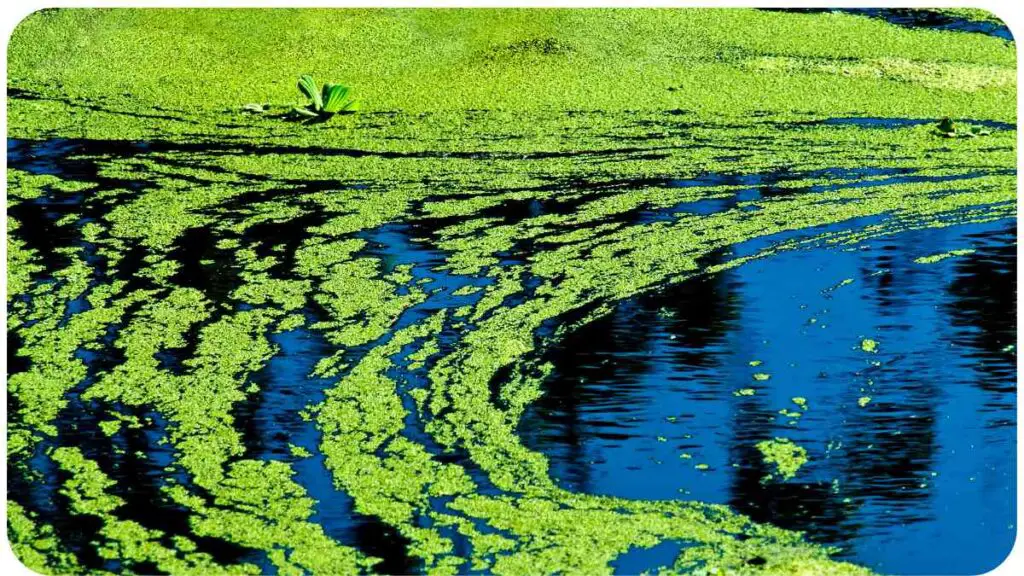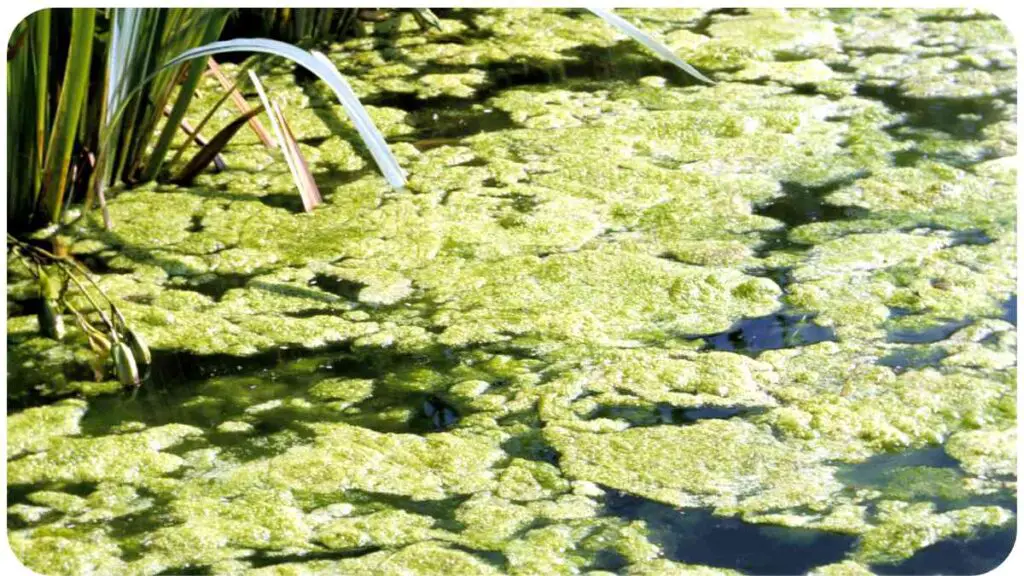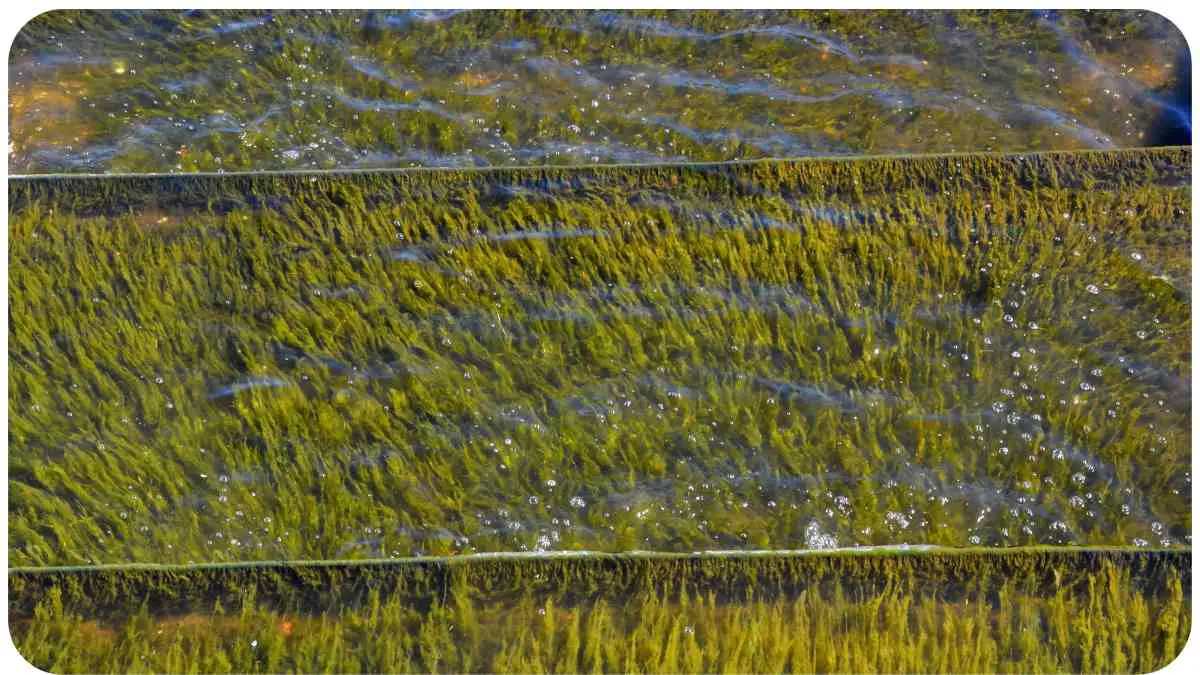Welcome to the world of garden water features! The soothing sound of flowing water, the mesmerizing ripples, and the vibrant aquatic life can turn any garden into a peaceful oasis. However, many garden enthusiasts have faced a common issue – the persistent bloom of algae in their water features.
In this comprehensive guide, we’ll explore the reasons behind algae growth, share expert insights, and offer practical tips to help you maintain a clear and beautiful garden water feature. Whether you have a pond, fountain, or any other water element, this article is your go-to resource for algae control.
| Takeaways |
| Understand the factors contributing to algae growth. |
| Proper water circulation is crucial for algae control. |
| Choose algae-resistant features and materials. |
| Regular maintenance is essential for algae prevention. |
| Explore natural and chemical algae control methods. |
| Balance pH levels and manage nutrient concentrations. |
| Consider the role of fish in algae management. |
| Implement DIY and professional solutions as needed. |
| Embrace sustainable gardening practices for long-term success. |
2. Understanding Algae in Garden Water Features
2.1 What Causes Algae Growth?
To combat algae effectively, you must understand what encourages its growth. Algae thrive in conditions with an abundance of nutrients, sunlight, and stagnant water. When these factors align, you’ll notice green or brownish water, and your once-pristine feature can start to resemble a swamp.
Implementing sustainable landscaping not only benefits the environment but also your wallet. Discover money-saving tips that make eco-friendly choices accessible and cost-effective for your outdoor space.
2.2 The Impact of Sunlight
Sunlight plays a pivotal role in algae proliferation. It provides the energy needed for photosynthesis, allowing algae to multiply rapidly. If your water feature receives plenty of direct sunlight, you’re more likely to experience algae problems.
2.3 Nutrients in the Water
Nutrients, such as nitrogen and phosphorus, act as algae’s food source. These nutrients can enter your water feature through decaying organic matter, runoff, or even fish waste. Controlling nutrient levels is crucial to preventing algae blooms.
2.4 Temperature and Algae

Warmer temperatures promote algae growth. As the mercury rises, algae become more active. If your region experiences hot summers, you’ll need to be especially vigilant in managing algae.
Designing a garden is an art, and our guide provides expert advice and inspiring ideas for creating a beautiful and harmonious outdoor oasis. Elevate your garden design with these valuable insights.
Table 1: Factors Affecting Algae Growth
| Factor | Impact on Algae Growth |
| Sunlight | Increases photosynthesis activity |
| Nutrients | Provides essential food source |
| Temperature | Promotes rapid growth |
3. The Role of Water Circulation
Now that we’ve established the key factors influencing algae growth, let’s delve into practical solutions. Proper water circulation is a fundamental aspect of algae control.
3.1 Importance of Proper Water Flow
Stagnant water is a haven for algae. It allows them to settle and reproduce comfortably. To disrupt their growth, ensure your water feature has adequate circulation. This prevents algae from finding stable surfaces to cling to.
3.2 Choosing the Right Pump
Investing in a high-quality pump is a wise decision. It not only keeps the water moving but also filters out debris and particles that can serve as a nutrient source for algae. Look for pumps designed for your specific feature size and type.
Table 2: Pump Recommendations for Different Feature Types
| Feature Type | Recommended Pump Model |
| Pond | XYZ Pond Pump 5000 |
| Fountain | AquaFlow 2000F Fountain Pump |
| Waterfall | CascadePro 4000 Waterfall Pump |
3.3 Adding Aeration
Aeration devices like fountain nozzles or diffusers can enhance water circulation and oxygenation. Algae struggle to thrive in well-oxygenated water, so these additions can help maintain a clear and healthy feature.
4. Algae-Resistant Water Features

Creating an environment that discourages algae growth is essential. Consider these factors when designing or renovating your water feature.
Maintaining a water feature is essential for its longevity and appeal. Follow 15 easy steps to keep your water feature pristine and enhance the overall beauty of your garden or outdoor space.
4.1 Pond Liner Materials
The type of liner you choose can impact algae growth. EPDM rubber liners are less hospitable to algae compared to PVC liners, as they provide fewer crevices for algae to cling to.
4.2 Shade and Plant Cover
Natural shade from trees or strategically placed plants can reduce the amount of direct sunlight reaching the water. Moreover, aquatic plants like water lilies can compete with algae for nutrients, helping to keep their population in check.
4.3 Beneficial Plants
Certain aquatic plants, such as hornwort and anacharis, release chemicals that inhibit algae growth. Consider incorporating these into your water feature for added protection against blooms.
Table 3: Algae-Resistant Water Feature Elements
| Feature Element | Recommended Options |
| Pond Liner | EPDM Rubber Liner, Avoid PVC Liner |
| Shade and Plants | Natural Shade, Water Lilies |
| Beneficial Plants | Hornwort, Anacharis |
5. Regular Maintenance Tips
Maintaining a pristine water feature requires ongoing attention and care. Let’s explore some essential maintenance tips.
5.1 Cleaning Debris
Regularly remove leaves, twigs, and other debris from the water surface and bottom. This debris can decompose, releasing nutrients that fuel algae growth.
Embarking on a landscape renovation project? Navigate the process seamlessly with the ultimate guide that covers everything from planning to execution. Transform your outdoor space with expert insights and essential considerations.
5.2 Algae Removal Strategies
If you spot algae in your feature, don’t panic. There are effective removal methods, such as using a pond skimmer or algae scraper. These tools help physically remove algae and prevent it from taking over.
5.3 Water Testing
Regularly test your water for pH levels, ammonia, and nitrate concentrations. Maintaining proper water chemistry can prevent conditions favorable to algae.
Table 4: Essential Maintenance Tips
| Maintenance Task | Frequency |
| Cleaning Debris | Weekly |
| Algae Removal | As needed |
| Water Testing | Monthly |
6. Natural Algae Control Methods
For those who prefer a more eco-friendly approach, there are natural methods to control algae.
6.1 Barley Straw
Barley straw is a natural algae inhibitor. When placed in your water feature, it releases compounds that deter algae growth. It’s a safe and environmentally friendly option.
6.2 Beneficial Bacteria
Introducing beneficial bacteria to your water can help break down organic matter, reducing nutrient levels and discouraging algae growth.
6.3 Pond Dye
Pond dye not only adds an appealing blue or black tint to your feature but also reduces the amount of sunlight penetrating the water, inhibiting algae photosynthesis.
Water features bring unique charm to your home, and our guide explores 10 surprising benefits that go beyond aesthetics. Discover how integrating a water feature can enhance your well-being and create a tranquil environment.
Table 5: Natural Algae Control Methods
| Method | How it Works |
| Barley Straw | Releases compounds that deter algae |
| Beneficial Bacteria | Breaks down organic matter |
| Pond Dye | Reduces sunlight penetration |
7. Chemical Algae Treatments
In some cases, chemical treatments may be necessary to combat stubborn algae blooms. It’s crucial to use them with care and follow instructions diligently.
7.1 Algaecides
Algaecides are chemical substances designed to kill algae. They can be effective, but it’s essential to choose the right type for your specific algae species and follow dosage instructions carefully.
7.2 Copper-Based Solutions
Copper-based treatments are often used to control algae. Copper ions are toxic to algae but can also harm fish and plants if used excessively. Maintain a balance to avoid adverse effects.
7.3 Safety Precautions
When using chemical treatments, wear appropriate protective gear and follow safety guidelines. Ensure that treated water is safe for pets and wildlife before allowing them back into the feature.
Table 6: Chemical Algae Treatments
| Treatment | Effectiveness | Safety Precautions |
| Algaecides | Effective | Follow dosage instructions |
| Copper-Based Solutions | Effective | Avoid excessive use |
8. Balancing Act: pH and Nutrients
Maintaining the right pH levels in your water feature is vital. Algae thrive in water with imbalanced pH levels. Regularly test and adjust the pH to discourage algae growth.
Additionally, monitor and manage nutrient levels. Remove excess nutrients by cleaning debris and using water treatments as necessary.
9. The Role of Fish in Algae Control
Fish can be your allies in the battle against algae. Many fish species, like koi and goldfish, consume algae as part of their diet. Introducing fish to your water feature can help keep algae populations in check.
Table 7: Algae-Control Fish Species
| Fish Species | Algae-Eating Behavior |
| Koi | Consumes algae |
| Goldfish | Feeds on algae |
10. DIY Algae Control Recipes
If you prefer a hands-on approach, here are some DIY recipes to help you control algae growth naturally.
10.1 DIY Algae Scrub
Ingredients:
- A scrub brush
- Elbow grease
Instructions:
- Gently scrub the sides and bottom of your water feature to dislodge algae.
- Use the scrub brush to remove algae from rocks or other surfaces.
- Rinse the algae debris out of your feature.
10.2 Homemade Algae Treatments
Ingredients:
- 1 cup of hydrogen peroxide (3% solution)
- 5 gallons of water
Instructions:
- Mix the hydrogen peroxide and water in a large container.
- Apply the solution directly to areas with algae growth.
- Allow it to sit for 15-20 minutes, then scrub the affected areas.
- Rinse thoroughly to remove the algae and hydrogen peroxide.
11. Professional Help and Services
If you find that algae issues persist despite your best efforts, consider seeking professional assistance.
11.1 Hiring a Pond Specialist
Pond specialists have the expertise to assess your specific situation and recommend tailored solutions. They can also provide maintenance services to keep your water feature in top condition.
11.2 Routine Maintenance Services
Many landscaping companies offer routine maintenance services for garden water features. Regular upkeep can prevent algae problems from recurring.
12. Troubleshooting Common Issues
Even with careful maintenance, issues may arise. Let’s address some common challenges you might encounter.
12.1 Recurring Algae Blooms
If algae blooms keep coming back, reevaluate your maintenance routine. Check for nutrient sources, water flow issues, or equipment malfunctions that might be contributing to the problem.
12.2 Water Quality Problems
If your water quality deteriorates, test for imbalances in pH, ammonia, or nitrate levels. Adjust as needed to create a healthier environment.
12.3 Fish Health Concerns
If your fish show signs of stress or illness, consult with a vet or fish expert. Poor water quality due to algae can affect fish health.
13. Sustainable Gardening Practices
Incorporating sustainable practices into your garden can reduce the likelihood of algae blooms. Collect rainwater for your feature, minimize chemical use, and choose native plants to reduce runoff and nutrient input.
14. Conclusion
Maintaining a clear and algae-free garden water feature requires a combination of understanding, regular maintenance, and the right strategies. By controlling nutrient levels, improving water circulation, and considering natural solutions, you can enjoy a beautiful and harmonious water feature year-round.
Remember, every garden is unique, so be prepared to adjust your approach based on your specific circumstances. With dedication and the knowledge shared in this guide, you can keep algae at bay and enjoy the serenity of your garden water feature to the fullest.
Further Reading
Here are some additional resources to help you further understand and tackle algae issues in your garden water feature:
- Types of Algae in a Water Garden: Explore the different types of algae commonly found in water gardens and gain insights into identifying and managing them.
- How to Stop Green Algae in Your Water Feature: Learn effective strategies for preventing and controlling green algae in your water feature, ensuring a crystal-clear look.
- Preventing Algae Blooms in Ponds: Discover proactive measures and preventive techniques to keep algae blooms at bay and maintain a healthy pond environment.
FAQs
Q: What are the common types of algae found in garden water features?
A: Algae in garden water features can include green algae, string algae, and blue-green algae, each with its unique characteristics and management methods.
Q: How can I identify the type of algae growing in my water feature?
A: Algae identification often involves examining color, texture, and growth patterns. Online resources and professional assistance can help with precise identification.
Q: Is there a safe and natural way to control algae in my pond or fountain?
A: Yes, several natural methods, such as using barley straw, beneficial bacteria, and pond dye, can help control algae growth without resorting to chemicals.
Q: What role do fish play in algae control in a water feature?
A: Certain fish species, like koi and goldfish, feed on algae, contributing to its control. Introducing these fish can be an effective algae management strategy.
Q: How often should I test the water quality in my garden water feature?
A: Regular water testing, typically on a monthly basis, is advisable to monitor pH levels, nutrient concentrations, and overall water quality, ensuring a balanced environment for your feature.

Hi! My name is Hellen James, and I’m a landscape designer in Los Angeles. I’ve been working with homeowners and businesses to help them improve the look of their properties for over 10 years.


